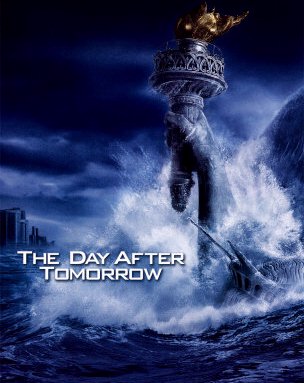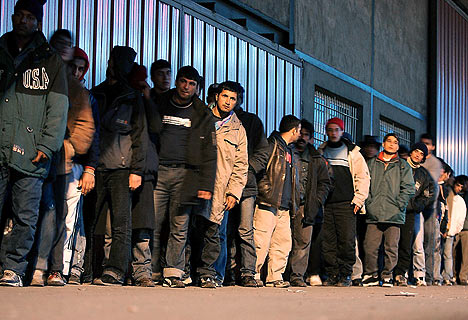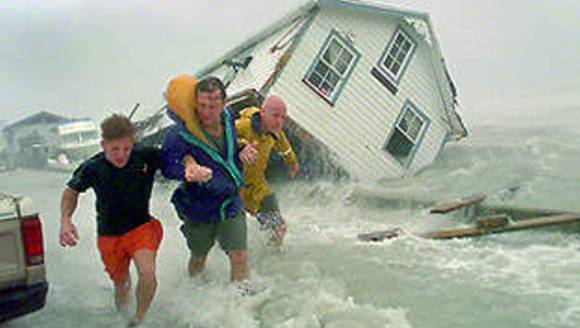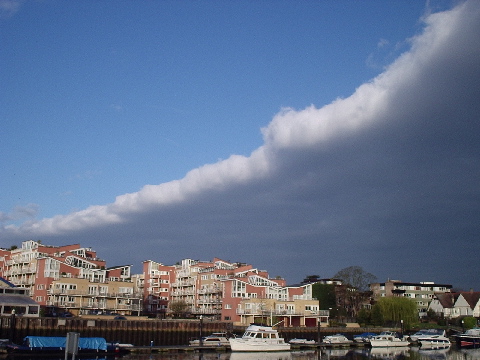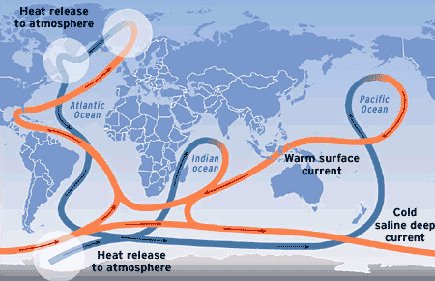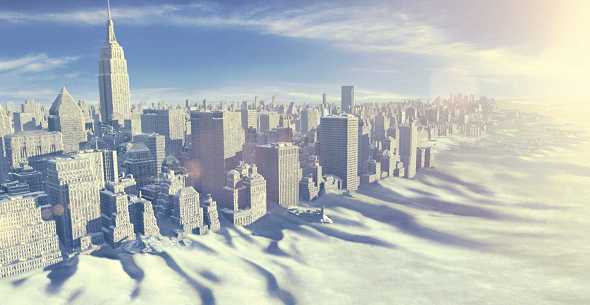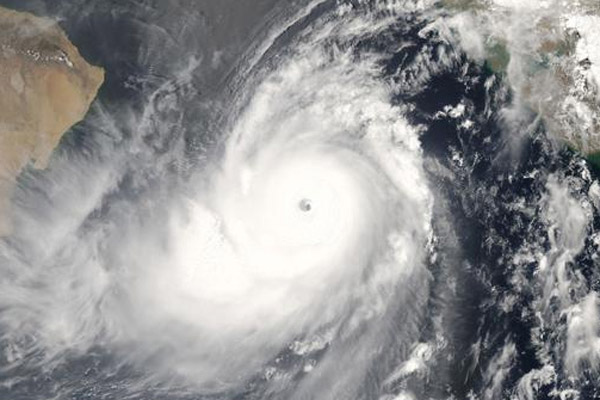|
|
|||||||||||||||||||||||||||||||
|
The Theory of Rapid Climate Change
Rapid climate change could trigger mass migrations, food & water shortages and war, but is it a real threat?By Suzanne MacNevin - February 2008. Rapid climate change, like that seen in the feature film "The Day After Tomorrow", may seem like pretty scary and unrealistic stuff. Is it a real threat to our society however? And how serious is that threat? To help make sense of it we have colour coordinated the following possible threats according to which is the most dangerous and likely to occur. Think of them as "level of severity" just like the Homeland Security terrorism threat level. If it reaches red in real life, you know we're in deep trouble. THREAT LEVEL YELLOW - More Deserts The United States, Mexico and Australia are currently suffering under heavy droughts and the deserts in all three countries grow every year. If the problem continues to get worse it means there will be less farming land to grow crops. This is not however a serious threat to America or Australia's food supplies, as the two countries already produce more food than they can eat. Rapid climate change could be both friend and foe in the agricultural business. Regions which received little rain before may receive a lot more and regions that had plenty could go thirsty in lengthy droughts. Warmer regions in northern Canada might allow farmer in the north to grow more crops. A larger threat is dwindling water supply in regions that are already thirsty. If people can't find water to drink or water for their plants/animals whole regions could become ghost towns as everyone packs up and leaves. This would be especially harsh in countries where there is few wells for water.
THREAT LEVEL ORANGE - Mass Migrations
Lack of water and food could lead to mass migrations, similar to the ghost towns mentioned above but on a much larger scale. Imagine for example if a large chunk of Mexico's population decided to suddenly migrate north due to lack of food and clean water. The United States already has huge problems controlling the flow of immigrants across their border with Mexico, but global warming and climate change will undoubtably make that task more difficult if the immigrants are fleeing the desertification of their country. Depending on the political leadership in the USA (or the lack of it) we could see riots and a possible (civil) war on as Americans come to grips with their thirsty neighbours to the south. Depending on how bad the deserification in the American Midwest gets there could also be mass migrations to the east and west coasts of the United States, and also farther north to Canada. Other countries would deal with these problems differently, but there would doubtlessly be arguments and possibly violence over food and water resources. Depending on the nature and severity we could see countries going to war over access to clean water. This threat is not as credible, but some warning signs would be a sudden influx of immigrants from Mexico and/or central American countries. THREAT LEVEL CRIMSON - Rising Sea Levels One of the biggest and most serious threats of rapid climate change is warmer temperatures in the arctic and antarctic, and the possibility of rising sea levels if polar ice caps melt. Polar temperatures rise approx. 5 to 10 degrees C for every 1 degree that the global average rises. Even if temperatures rise gradually all it takes is for the average temperature in Greenland to rise above 0 Celsius and it will unleash a catastrophe of global flooding. The Greenland ice sheet covers over 90,000 square kilometers and is over 2000 meters thick in some areas. If it melts completely it would raise sea levels around the world by approximately 7 meters (about 23 feet). Currently the Greenland ice sheet is melting at approx. 20 times the rate of water going over Niagara Falls as water scours through icy canyons ten times the size of the Grand Canyon. If the average daily temperature in Greenland rose above 0 Celsius for a week sea levels around the world would rise approx. 1 meter. Hopefully such a "heatwave" in Greenland would be shortlived. Even if the sea level only went up 3 meters (10 feet) coastal cities like Los Angeles, Boston, Miami, New York, London, Hong Kong, Sydney and numerous other cities would be flooded because most of their buildings are built in the flood plains. The Greenland ice sheet is 110,000 years old, dating back several ice ages and dates back to a time when much of the United States was under water. Quite a few states in the USA have 70% or more of their territory within the flood plains and a 23 foot rise in sea level would destroy most of Florida, Alabama, Texas and other states in the Gulf of Mexico region. But the Greenland ice sheet is not the only ice sheet that has been melting recently. The Antarctic ice sheet is also melting and is over 9 times bigger than the Greenland ice sheet. If just 5% of the Antarctic ice melts we could see an additional 10 foot rise in sea levels, so if 25% (which is conceivable) of it melted that would be another 50 feet. That kind of change, especially if it happens rapidly, could cause large amounts of people to migrate, food shortages, housing shortages and civil unrest. Think of the aftermath of Hurricane Katrina but imagine it happening to every other American port city, and indeed every port city, town and village in the world that has much of its buildings built at 70 feet above sea level or lower. The economic chaos from such a disaster will undoubtedly result in large countries exploiting small countries that are above the 70 foot mark, and small island countries that are entirely below the 70 foot mark to disappear entirely. England for example would see large sections of their island swallowed up by water leaving only the high lands and a severe shortage of space. Large parts of Africa and most of the Sahara desert would also be covered by salt water and would be useful only for fishing. The Pyramids of Egypt would be islands temporarily. (Apparently this has happened before, as archeologists discovered salt encrusted on the lower sections of the pyramid indicating a flood had taken place at some point around 10,000 BC.) Hopefully after the first 10 feet of sea level changes we would learn the errors of our ways, and hopefully not before it is too late.
The Rapid Fix Scenario Hypothetically if the sea levels suddenly did rise 10 feet suddenly over the course of a week how would we try to fix it? Obviously we can't all switch to hydrogen fuel cell cars immediately (the system for distributing hydrogen isn't even built yet), but we could conceivably shut down coal electricity plants immediately and rely only on nuclear and alternative energy. It would basically be the end of the coal industry, one of the cheapest and dirtiest sources of electricity around, account for approx. 30% of North America's greenhouse gas emissions. The price of electricity would go up approx. 20 to 30%, unless the government subsidized it. Over a period of 4 years severe cuts could be done. With government help industry could build the hydrogen network during the first year, giving automotive manufacturers time to start producing a lot more hydrogen cars and over a period of three years cut the number of non-hydrogen cars on the road in the United States down to half. Parts manufacturers could mass produce "replacement engines" and parts to convert existing cars into hydrogen cars. Industries that emit greenhouse gases would be forced (not by the government) by boycotts and their own staff demanding change to not just cut back on greenhouse gas emissions but to eliminate them entirely. It would bankrupt governments over the short term and the oil industry would be almost driven out of business. The oil industry would always have a place in making plastics and engine lubricants, but otherwise we would severely change our wasteful polluting ways in a matter of years. It is just sad that we will likely need a global catastrophe before we finally do anything about it.
Rapid Climate Change and the Public EyeTwo high-profile events are putting the issue of "abrupt climate change" squarely in the public eye. The first is a February 2004 Fortune Magazine article that broke the news of a report prepared for the Pentagon on abrupt climate change and its implications for U.S. national security. The Pentagon report describes a scenario in which human-caused global warming leads to a near-term collapse of the ocean's thermohaline circulation, which brings warm surface waters from the tropics to the North Atlantic, warming parts of Western Europe. The authors propose dramatic impacts, including rapid cooling in Europe, greatly diminished rainfall in many important agricultural and urban centers and consequent disruptions in food supply and water supply with enormous geopolitical and security implications. The second is the May 2004 release of The Day After Tomorrow a 20th Century Fox blockbuster disaster movie with a similar premise. With a dashing paleoclimatologist as the action hero, The Day After Tomorrow depicts a world careening toward an ice age over a few weeks' time. Here too, the culprit is the warming-induced shutdown of the thermohaline circulation. The authors of the Pentagon report and the producers of The Day After Tomorrow caution readers and viewers against treating these extreme scenarios as serious possibilities. The Pentagon report intentionally considers the worst possible scenario, one that stretches the boundary of scientific plausibility. The Day After Tomorrow leaps beyond that boundary to unleash a collection of climate catastrophes intended to thrill audiences and showcase the latest special effects. Yet underlying even these extreme scenarios are the sober facts of human-caused global warming and the real opportunities to minimize climate change by reducing emissions of heat-trapping gases.
Can what happens in The Day After Tomorrow happen in real life?No. The dramatic, virtually instantaneous and widespread cooling envisioned in the film is fiction. But like all good science fiction, the film is premised on several important scientific facts. We know with great certainty that Earth is already warming, largely because as we burn fossil fuels and clear forests we are releasing carbon dioxide and other heat-trapping gases in the atmosphere. This warming is expected to continue in the coming decades, accompanied by changes in rainfall patterns and rising sea levels. The possibility of an abrupt shift in the climate system is only one feature of a changing climate that is expected to become more erratic, with extreme weather events like droughts, torrential rainfall, and extreme heat becoming more common. We can slow down global warming and reduce the likelihood of future abrupt climate changes by reducing our emissions of heat-trapping gases.
What is "abrupt climate change?"The term "abrupt climate change" describes changes in climate that occur over the span of years to decades, compared to the human-caused changes in climate that are occurring over the time span of decades to centuries. From ice cores, ocean sediments, tree rings, and other records of Earth's past climate, scientists have found that changes in climate have occurred quickly in the past—over the course of a decade. An example of an abrupt climate change event is the Younger Dryas (~12,000 years ago), a period of abrupt cooling that interrupted a general warming trend as Earth emerged from the last Ice Age. During the Younger Dryas period, average summertime temperatures in New England cooled by about 5-7°F (3-4°C). This and other abrupt events have been linked to changes in an ocean circulation pattern known as thermohaline circulation.
How might abrupt climate change affect people?While the scenarios depicted in the Day After Tomorrow and the Pentagon report are extreme, changes in climate, including possible abrupt climate changes, will have serious consequences for people's lives and livelihoods. As Earth warms, higher temperatures and more common extreme heat conditions will affect human health, energy demand, water supply and demand, and agriculture. Rising sea levels will impact coastal communities as flooding happens more often and damage from coastal storms becomes more severe. Some regions will become much drier, while others will become much wetter, affecting agriculture, water supply, and the spread of diseases. Many of these impacts will be most severe in developing countries, where scarce resources and limited technological capacity will limit options for coping with the consequences of climate change.
Can we avoid abrupt climate change?Yes. While abrupt climate change is not a certainty, human-caused climate change makes abrupt events more likely. What is certain is that human-caused climate change is already under way, and is expected to continue over the next century as a result of our emissions of carbon dioxide and other heat-trapping gases to the atmosphere. Levels of carbon dioxide in the atmosphere are higher today than they have been for more than 400,000 years. Earth's surface temperature has increased measurably over the past 100 years, and 10 of the warmest years on record have occurred since 1990. This warming has caused changes in rainfall—some regions have become wetter while others have become drier—and droughts and severe rainfall events have become more common. By making choices now to reduce our emissions of heat-trapping gases, we can slow the rate of global warming and reduce the likelihood of unexpected climate changes.
How can global warming make things cooler?As we rapidly increase Earth's average temperature, some regions, such as high latitudes, will experience greater warming than others, such as the tropics. As warming alters ocean and atmosphere circulation patterns, some regions could even experience cooling. Much of Western Europe is now warmed by ocean circulation as well as the atmosphere. Heat is transported to the region by a global ocean circulation pattern variably known as thermohaline circulation, the North Atlantic heat pump, or the "Great Ocean Conveyor Belt." This "heat pump" pulls warm salty water northward from the tropics into the North Atlantic, where heat is released, warming air temperatures over Europe. As Earth warms, melting of ice caps and glaciers, increased precipitation and other inflows of fresh water to the North Atlantic Ocean may weaken or shut down thermohaline circulation. This change in ocean circulation could disrupt the transfer of heat northward from the tropics, resulting in cooling in the North Atlantic region. Regional cooling of as much as 14-29°F (8-16°C) has been seen in the past climate record. However, any regional cooling would be superimposed on the global warming that is already underway. Contrary to the "Day After Tomorrow" dramatization, abrupt climate change will not result in an ice age, because the cooling effects are regional and Earth is currently in an interglacial, or warm, period.
What is thermohaline circulation?Thermohaline circulation is a global ocean circulation pattern that distributes water and heat both vertically, through the water column, and horizontally across the globe. As cold, salty water sinks at high latitudes, it pulls warmer water from lower latitudes to replace it. Water that sinks in the North Atlantic flows down to the southern hemisphere, skirts the Antarctic continent, where it is joined by more sinking water, and then crosses south of the Indian Ocean to enter the Pacific Ocean basin. There, the cold deep water rises to the surface, where heat from the tropical sun warms the water at the ocean's surface and drives evaporation, leaving behind saltier water. This warm, salty water flows northward to join the Gulf Stream, traveling up the Eastern coast of the United States and across the Atlantic Ocean into the North Atlantic region. There, heat is released to the atmosphere, warming parts of Western Europe. Once this warm, salty water reaches the North Atlantic and releases its heat, it again becomes very cold and dense, and sinks to the deep ocean.
|
|
||||||||||||||||||||||||||||||
|
Website Design + SEO by designSEO.ca ~ Owned + Edited by Suzanne MacNevin | |||||||||||||||||||||||||||||||
